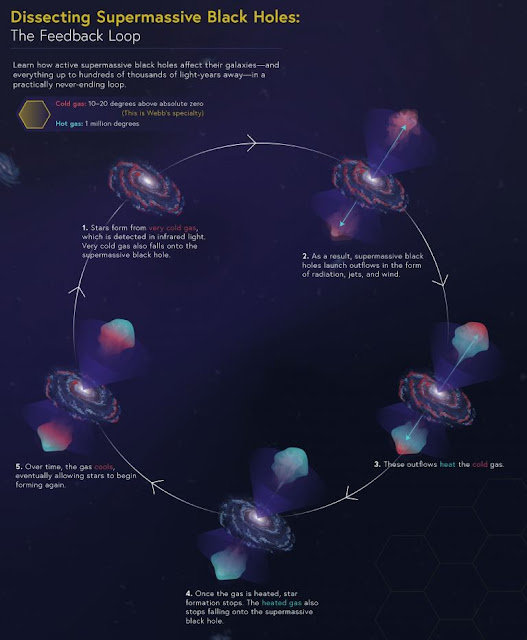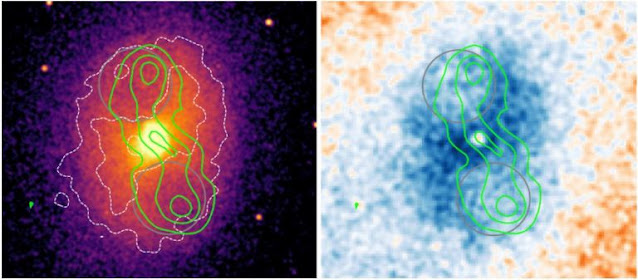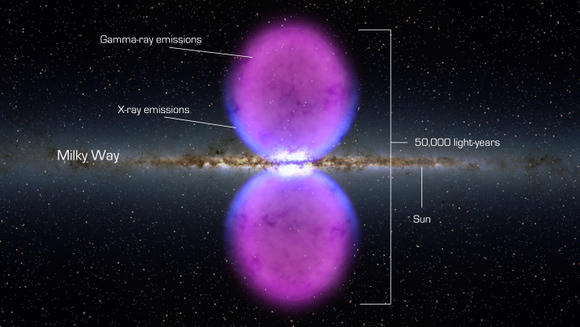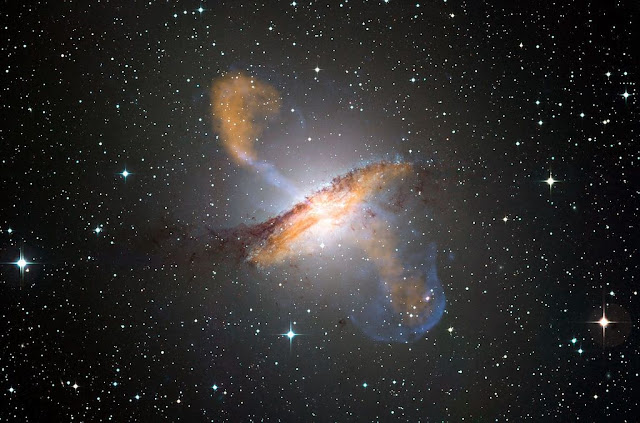Amazing Black Hole has been Burping for 100 Million Years
Black holes are gluttonous behemoths that lurk in the center of galaxies. Almost everybody knows that nothing can escape them, not even light. So when anything made of simple matter gets too close, whether a planet, a star or a gas cloud, it’s doomed.
But the black hole doesn’t eat it at once. It plays with its food like a fussy kid. Sometimes, it spews out light.
When the black hole is not only at the center of a galaxy but the center of a cluster of galaxies, these burps and jets carve massive cavities out of the hot gas at the center of the cluster called radio bubbles.
Astronomy and astrophysics are all about light. Almost everything we know about distant objects in space, including black holes, comes from observing light. (Gravitational waves are the exception.)
The light astronomers see when they observe a black hole is coming from the environment in the vicinity of the black hole, not from the black hole itself. The behemoth’s strong gravity means that anything that gets too close is like a puppet on a string, and the black hole is the puppet master.
In a new study, a team of researchers using the National Science Foundation’s Green Bank Telescope (GBT) examined a supermassive black hole (SMBH) burping out mysterious radio bubbles.
“This is what happens when you feed a black hole, and it violently burps out a giant amount of energy.” – Jack Orlowski-Scherer, lead author, McGill University.
The study is “GBT/MUSTANG-2 9 resolution imaging of the SZ effect in MS0735.6+7421,” and it was published in the journal Astronomy and Astrophysics. The lead author is Jack Orlowski-Scherer, a graduate student at the University of Pennsylvania at the time the study was done. “This is what happens when you feed a black hole, and it violently burps out a giant amount of energy,” he said in a press release.
Supermassive black holes reside in the center of large galaxies like the Milky Way. They’re found in every large galaxy, including the galaxies at the heart of galaxy clusters. The heart of a galaxy cluster is an extreme environment. The plasma there is scorching, up to 50 million degrees Celsius (90 million F.)
That plasma radiates x-rays, and over time that dissipates the heat. The plasma cools down, allowing stars to form. It’s sort of like the Universe’s situation after the Big Bang. Only after things cooled down could stars form.
Sometimes a black hole will reheat the surrounding gas preventing stars from forming. That’s called black hole feedback, and it happens when black holes emit jets of heated material from their centers. The jets are enormously powerful, pushing away the hot x-ray-emitting gas in the galaxy cluster’s center, creating vast radio bubbles.

While that description makes the process sound straightforward, it’s not. It takes enormous energy to move that much gas, and astrophysicists want to know where all of that energy comes from. In this study, the researchers probed the radio bubbles for clues to the energy source.
The Green Bank Telescope is a fully steerable radio telescope—the world’s largest—located in West Virginia. Its collecting area is 100 meters in diameter. The MUSTANG-2 receiver is a type of camera called a continuum receiver that operates across multiple channels.
The team aimed the instrument at the galaxy cluster MS0735. It’s about 2.6 billion light years away and is known for having an enormously massive black hole in its center. The jets coming from the black hole in the center are one of the most powerful active galactic nucleus eruptions ever recorded. The eruption has been going on for over 100 million years and has released as much energy as hundreds of millions of gamma-ray bursts.
“We’re looking at one of the most energetic outbursts ever seen from a supermassive black hole,” said lead author Orlowski-Scherer.
The jets are the likely culprits behind the radio bubbles, but exactly how they work is unknown. Somehow, they provide the heat that prevents star formation. “Jets are the main drivers of ICM (Intra-Cluster Medium) reheating, although the exact mechanism is not clear yet,” the authors explain in their paper. “It is known that the jets, as traced by their synchrotron emission, often terminate in radio lobes that are coincident with depressions (cavities) in the X-ray emission.”
These jets are what carved out the radio bubbles, and the team studied them for clues to how it all plays out.
The region is difficult to observe, but the team used MUSTANG-2’s power to peer into the bubbles. They took advantage of a phenomenon called the Sunyaev-Zeldovich (SZ) effect. The SZ effect is a subtle distortion of the Cosmic Microwave Background (CMB,) sometimes called the echo from the Big Bang. It’s relic radiation from the moment the Universe began over 13 billion years ago. The SZ effect registers as a slight thermal pressure at 90 GigaHertz, where MUSTANG-2 can sense it. 90 GHz is in the millimetre band because radio waves in this band have wavelengths from one to ten millimetres.

“With the power of MUSTANG-2, we are able to see into these cavities and start to determine precisely what they are filled with and why they don’t collapse under pressure,” said Tony Mroczkowski. Mroczkowski is an astronomer with the European Southern Observatory who was part of this new research.
This study isn’t the first time astrophysicists have studied these radio bubbles. Those efforts showed that the pressure inside these bubbles wasn’t entirely thermal. They pointed to relativistic particles, cosmic rays, and turbulence as causes, as well as a small contribution from magnetic fields. “Broadly, the support mechanisms can be broken down into two categories: thermal and non-thermal,” the team explains in their paper.
But the observations in this new study are the deepest high-fidelity SZ observations yet of the inside of the bubbles. That’s important because the SZ effect can distinguish thermal pressure causes from non-thermal pressure and relativistic electron causes. This study’s results show more nuance in the cause of the cavities, including thermal and non-thermal sources.
“We knew this was an exciting system when we studied the radio core and lobes at low frequencies, but we are only now beginning to see the full picture,” explains co-author Tracy Clarke. Clarke’s an astronomer at the U.S. Naval Research Laboratory and VLITE Project Scientist who co-authored a previous radio study of this system.

Galaxy clusters are important because they’re the endpoints of structure formation in the Universe. They grow continuously through mergers and accretion. Theory and calculations show that some of their energy is not yet thermalized, meaning it comes from turbulence and bulk motion. Researchers want to know how much of a cluster’s pressure support is not thermal because that helps them understand how the gas in the intra-cluster medium reaches equilibrium. That’s called virialization, and it leads to star formation.
It all relates to the problem of black hole feedback, which prevents stars from forming. Studies like this one that uses the GBT/MUSTANG-2 receiver across multiple frequencies can start to untangle this complex environment by determining how thermal and non-thermal pressures support the radio bubbles. Scientists would like a clearer understanding of how turbulence, magnetic fields, and even cosmic rays support these bubbles.
“This work will help us better understand the physics of galaxy clusters and the cooling flow feedback problem that has vexed many of us for some time,” added Orlowski-Scherer.
Press Release: Scientists Reveal Secrets to Burping Black Hole with the Green Bank Telescope
Published Research: GBT/MUSTANG-2 9 resolution imaging of the SZ effect in MS0735.6+7421
Do not forget to share your opinion with us to provide you with the best posts !




0 Comments